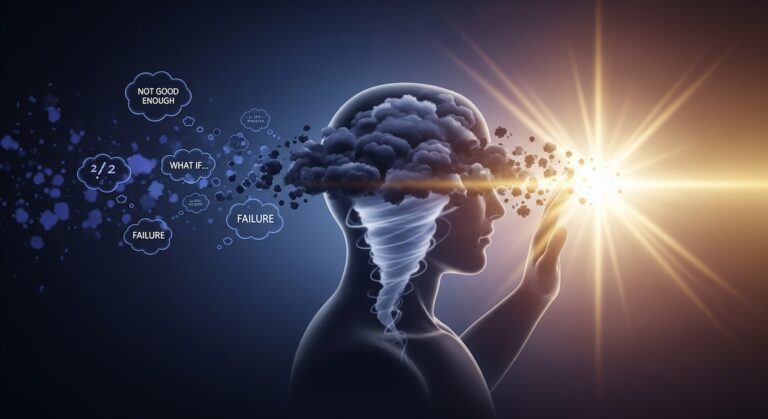Living with ADHD often means navigating challenges with focus, impulsivity, restlessness, and emotional regulation. While medication and therapy are common treatments, many find that incorporating meditation for ADHD provides valuable complementary support, helping to train the brain for greater calm and improved attention.
It might seem counterintuitive, sitting still when your mind wants to race. But specific meditation practices can directly target core ADHD symptoms. This guide explores how meditation helps ADHD, suggests suitable techniques, and offers tips for adapting the practice to an ADHD brain.
Understanding the Connection: How Does Meditation Help with ADHD?
ADHD involves differences in brain structure and function, particularly in areas related to executive functions like attention, working memory, and impulse control (often involving the prefrontal cortex). Meditation practices, especially mindfulness, appear to strengthen these very areas:
- Trains the “Attention Muscle“: The core practice of noticing when the mind wanders and gently bringing it back is attention training. It strengthens the neural circuits involved in focusing and resisting distractions.
- Improves Working Memory: Holding focus on the breath or a mantra can enhance the ability to keep information in mind.
- Reduces Impulsivity: By creating awareness of thoughts and urges before acting on them, meditation helps develop impulse control. You learn to pause rather than react immediately.
- Enhances Emotional Regulation: Mindfulness helps individuals with ADHD recognize and manage frustration, boredom, or emotional reactivity more effectively.
- Promotes Calm and Reduces Restlessness: While challenging initially, regular practice can help calm the nervous system and reduce feelings of inner restlessness over time.
- Increases Self-Awareness: Helps individuals better understand their own thought patterns, triggers, and energy levels.
Best Meditation Techniques for ADHD
Standard meditation instructions might need slight adaptation for ADHD. Focus on shorter sessions and techniques that engage attention gently:
1. Short Mindfulness of Breath Sessions
- Why it works: Direct attention training using an ever-present anchor. Short duration makes it manageable.
- How-to: Start with just 1-3 minutes. Sit comfortably. Focus on the sensation of breathing. Expect your mind to wander a lot, that’s okay! The key is the gentle returning of focus, over and over. Don’t judge the wandering; celebrate the noticing and returning.
2. Walking Meditation
- Why it works: Incorporates movement, which can be helpful for restlessness. Provides clear physical sensations to focus on.
- How-to: Walk slowly back and forth. Focus intently on the sensation of your feet making contact with the ground, lifting, and moving. If helpful, silently note “lifting,” “moving,” “placing.” When your mind drifts, bring it back to the feeling of walking.
3. Focused Attention on Sound or Objects
- Why it works: Uses external stimuli as the meditation anchor, which can sometimes be easier to grasp than the breath.
- How-to:
- Sound: Sit quietly and focus on a specific, continuous sound (like a fan humming, ambient music, or a ticking clock). When your mind wanders, bring it back to simply listening to the sound.
- Object: Gently gaze at a simple object (like a candle flame, safely!, a stone, or a spot on the wall). Notice its details without analyzing. When thoughts pull you away, return your gaze and attention to the object.
4. Body Scan (Possibly Adapted)
- Why it works: Connects mind and body, can be grounding.
- Adaptation: Keep it shorter initially. Instead of very detailed scanning, focus on larger body areas (whole foot, lower leg, etc.) or simply scan for areas of tension or notable sensation.
Practical Tips for Meditating with ADHD
- Start SUPER Short: 1-3 minutes is a fantastic start. Gradually increase only if and when it feels manageable. Consistency is far more important than duration.
- Embrace Movement: Don’t feel you must sit perfectly still. Gentle swaying, walking meditation, or even mindful stretching can be effective forms of practice.
- Use Timers: A clear start and end time reduces anxiety about duration. Use a gentle alarm.
- Fidgeting is Okay (Sometimes): If needing to fidget slightly helps you focus on the meditation object (like the breath), allow it. If the fidgeting becomes a distraction, gently notice that and return focus. Experiment.
- Acknowledge Boredom/Restlessness: These feelings will arise. Don’t fight them. Acknowledge them (“Ah, boredom is here”) and gently return your focus to your chosen anchor. This builds tolerance.
- Use Guided Meditations: Apps often have meditations specifically for focus or ADHD, which can provide helpful structure.
- Be Extremely Patient & Kind: The ADHD brain wanders more, that’s the nature of it. Each time you notice and return focus, you are successfully practicing and strengthening your brain. Celebrate the effort, not perfection.
Managing Expectations
Meditation is a tool, not a cure for ADHD.
- It’s Training, Not Instant Fix: Think of it like building muscle, results come with consistent practice over time.
- Benefits May Be Subtle at First: You might first notice being slightly less reactive, or catching distractions a split second sooner.
- It Complements Other Treatments: Meditation works best alongside strategies like medication (if prescribed), therapy, coaching, and lifestyle adjustments.
Conclusion: Training Your Brain for Clarity and Calm
Living with ADHD presents unique challenges, but also unique strengths. Adding meditation for ADHD to your toolkit can be a game-changer, offering a way to actively train your attention, manage impulsivity, and cultivate a sense of inner calm. Forget perfection, embrace short, consistent sessions, adapt techniques to suit your needs, and meet yourself with radical patience and kindness. Each mindful breath, each gentle return of focus, is a step towards harnessing the power of your own mind.




